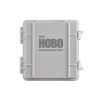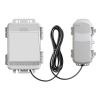HOBOnet Wireless Analog Mote
Features
- Supports and connects up to four analog sensors, with an ability to swap or replace sensors
- Delivers high 15-bit resolution and accuracy
- Offers versatile sensor compatibility with eight voltage input ranges up to 20.48V
- Free ground shipping
- Expedited repair and warranty service
- Lifetime technical support
- More
Overview
The HOBOnet Analog Mote enables users to quickly and easily integrate their preferred/popular 3rd party analog output sensors with the HOBOnet remote sensor network's robust data logging, telemetry, and flexibility features. Deploying this Mote gives you the versatility and adaptability to:
- Support popular 3rd party sensors that are included with the LI-COR Cloud remote monitoring platform
- Swap and/or reprogram your sensors to optimize your system
- Expand your existing monitoring system without purchasing additional stations—without complicated configuration steps
- Add sensors (like light) requiring a lower signal range, thanks to a low voltage range of 0-160 mV
Features
- Enables integration with HOBOnet system, which streamlines deployment, provides alarm notifications, connects to LI-COR Cloud monitoring platform's robust tools, and more
- Supports and connects up to four analog sensors, with an ability to swap or replace sensors
- Delivers high 15-bit resolution and accuracy
- Offers versatile sensor compatibility with eight voltage input ranges up to 20.48V
- Allows configuration for scaled parameters
- Provides ability to enable sampling
- Reliable power sources from integrated solar panel for battery recharge as well as AC power
0 to 25.6mA, +/-5uA +/0.20% of reading
0 to 160mV, +/-2mV +/-0.25% of reading
0 to 320mV, +/-1mV +/-0.25% of reading
0 to 640mV, +/-0.5mV +/-0.25% of reading
0 to 1.28V, +/-0.25mV +/-0.25% of reading
0 to 2.56V, +/-0.25mV +/-0.25% of reading
0 to 5.12V, +/-0.25mV +/-0.25% of reading
0 to 10.24V, +/-0.25mV +/-0.25% of reading
0 to 20.48V, +/-0.25mV +/-0.25% of reading
- HOBOnet Wireless Analog Mote
- Grease packet
- Screws and washers
- Cable ties
- 2 cable channels
- Rechargeable battery pack
In The News
Long-Term Monitoring in the Chautauqua Lake Watershed
With a widely developed shoreline, Chautauqua Lake experiences influxes of non-point source pollution that have historically impacted the health of the lake. The Chautauqua Lake Association (CLA) has been monitoring the lake for over two decades, reporting on changes that have occurred over the years. A pair of local lake advocates, Jane and Doug Conroe, have lived on the lake for over 40 years and have played an important role in establishing monitoring programs and facilitating consistent data collection throughout the watershed. Doug has been involved with the Chautauqua Lake Association (CLA) since the pair moved to the area in 1980, and is currently serving as the Executive Director.
Read MoreNo Red Herrings: Data Driving the Largest Salt Marsh Restoration in the NE USA
The Herring River system encompasses around 1,000 acres in the Towns of Wellfleet and Truro, Massachusetts. In 1909, the Chequessett Neck Road dike was built at the river’s mouth, drastically limiting tidal flow. Today, it’s one of the most restricted estuaries in the northeastern United States. As a result, the area has suffered environmental decline, including poor water quality, hypoxia, lower pH, and salt marsh degradation. In 2023, the Town of Wellfleet received $14.7 million from NOAA’s Office of Habitat Conservation to fund the Herring River Restoration Project (HRRP). Francesco Peri, President and CEO at Charybdis Group LLC, uses a network of NexSens data loggers to monitor water level and water quality on the Herring River.
Read MoreCarbon and Nutrient Monitoring in the Great Lakes Using Satellite Observations
Carbon and nutrients are the foundation of lake food webs and play an important role in the chemical and physical processes that shape aquatic ecosystems and various lake dynamics. Studying these cornerstones can help improve understanding of other lake conditions like harmful algal blooms, hypoxia, and phytoplankton community composition. The way in which these characteristics are monitored varies, though many rely on a proxy approach wherein parameters are extrapolated from the measurement of a different parameter. An assistant professor at Cleveland State University, Brice Grunert, is working to improve current strategies and take a satellite approach to monitoring the Great Lakes.
Read More



















